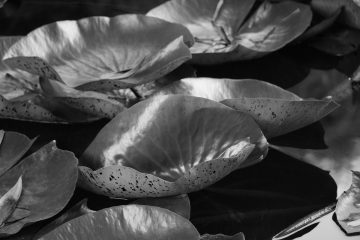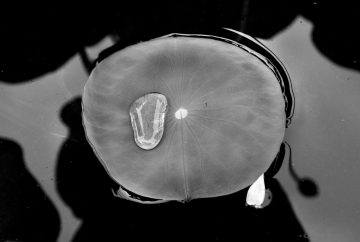 by Leanne Ogasawara
by Leanne Ogasawara
Photographs by Tracey Parmley Nuki
1.
Back from three weeks on the road, I immediately consult my Japanese almanac. To my delight, I see we are now in the Time of White Dew (白露):
Falling just prior to the Autumnal Equinox, the sun is said to have passed the 165th solar degree on its journey south. Although the afternoons are still dominated by the lingering heat of August and September, Autumn-like weather can increasingly be felt, deepening with each passing rain shower, especially noticeable in the mornings and evenings as the equinox approaches.
It’s like clockwork. Every year, by mid-September, the dew point is reached and suddenly there are glistening dewdrops –like diamonds– scattered in the morning grass.
This was true in Tokyo and it’s true in Los Angeles.
In Japan, these pearly gems are not only treasured for their gem-like beauty, but they are also appreciated for their fleetingness; which, like scattering cherry blossoms, are likened to the transience of our human existence. For life, like the disappearing dewdrops in the morning sunlight, is too often cut short. In this way, dewdrops have been considered, since ancient times, along with “scattering flowers and fallen leaves” (飛花落葉) as a poetic metaphor for impermanence, or mujo (無常).
Have you heard of the dewdrop world?
In Japan, human transience became so associated with the autumn dew that our frailty was referred to as our “dewdrop world” (tsuyu no yo 露の世); or as our “dewdrop lives” (tsuyu no inochi 露の命), our “dewdrop bodies” or “dewdrop selves” (tsuyu no mi 露の身). One of the most famous haiku written on this theme is one by Issa who, devastated after the loss of his beloved one-year old daughter, lamented:
露の世は露の世ながらさりながら
一茶
this world of dew-
is yes, a world of dew
and yet…
-Issa
The above translation is by Patricia Donegan. I really like the translation since she emphasizes the sorrow of things. “Yes,” says Issa, life is fleeting and precarious. filled with sadness. Like dewdrops fated to fade away in the morning sunshine, our lives are all too fragile. Yet even in knowing this, still the poet whispers “and yet…” This is something you can’t help but feel in early autumn. After all, the world itself seems to be in a process of death and decay:
秋風に
なびく浅茅の
末ごとに
おく白露の
あはれ世の中
White dew
poised at the tips of
grass, fluttering
in the autumn wind-
What a fragile, fleeting world
– Semimaro, Shin-kokinshu
The above poem is from the second imperial anthology of court poetry, compiled in the 15th century. What a fragile and fleeting world, says the poet. But so beautiful too. For indeed, precisely what is fragile and fleeting is what is considered beautiful, as Japanese monk Yoshida Kenkō remarked in his Essays in Idleness :
If man were to never fade away like the dews of Adashino…. but lingered on forever in the world, how things would lose their power to move us!
Buddhism, of course, also teaches that nothing in life can escape the law of anitya or “necessary change” and that all life inevitably must perish.
The Heart Sutra teaches that, All that appears before us is as a dream, an illusion, a bubble, a shadow. All is like the dew or lightening. It should thus be contemplated that nothing has reality. That everything is in flux and that all must eventually perish is a sad but inevitable fact that somehow seems all the more apparent in this season of sparse autumn grass, disappearing dewdrops and sudden, passing thunderstorms.
 2.
2.
We know from classical Chinese poetry that the appreciation of mid-autumn dewdrops and late-autumn to early-winter frost dates back at least to the Warring States Period (BC 453-221) This ancient Chinese love of dewdrops also becomes apparent when we take a look at the calendar itself. Of the six seasonal names of autumn, three are named after the dew or frost:
August 8th 立秋 The Time of First Day of Autumn
August 23rd 処暑 The Time of Manageable Heat
September 8th 白露 The Time of White Dew
September 23rd 秋分 The Time of the Autumnal Equinox
October 9th 寒露 The Time of Cold Dew
October 24th 霜降 The Time of Frost Falling
Because dewdrops become especially noticeable around the time, when the autumn leaves change colors, I suppose it was inevitable that the ancients connected the changing leaves to the dew, and wondered if it wasn’t it perhaps the abundant dew which, seeping into the leaves of the trees at night, somehow stained them the many different autumn colors? Not only was it the dew that was thought of to be the reason behind the spectacular brocade of autumn foliage, but frost and the autumn rain showers were also posited as possible causes for why the leaves changed colors so dramatically around this time of year.
As an aside, my personal preferred explanation for why the leaves changed colors doesn’t involve the dew at all, but rather the tears of passing geese:
秋の夜の
露をば露と
置きながら
雁の涙や
野辺を染むらむ
Might it not be that
the dewdrops forming on Autumn nights
are only just that- dewdrops
And that it’s the tears of passing geese
which stain the fields red
– Mibu no Tademine
Kokinshu 258
 3.
3.
In the world of tea ceremony, or chanoyu, where purity is one of the four main principles, the garden path leading to any tearoom is called the “dewy ground” (or roji, 露地) and the origin of this name can be traced back to one of the most well-known stories in the Lotus Sutra about how the children of a wealthy man were made to flee a burning house. This parable extols us to escape the burning house of the “three worlds” (of worldly title, position and attachments) and to dwell in the purity of “white dewy ground.”
Poet Issa said it so beautifully:
朝露に浄土参りのけいこ哉
From the white dewdrops,
Learn the way
To the Pure Land
-Issa
The translation is by RH Blyth, who explains:
Just as the wind is used as a symbol of the unknown comings and goings of the spirit of life, so water is the type of our own life, its swift, willing obedience, its bright, active desirelessness. Above all, the dew drop that disappears so soon, leaving not a trace of itself behind, is our own soul, that is devoid of all qualities, free of any kind of permanence, is the white radiance of eternity.
Sen Soshitsu, the Grand Tea Master of the Urasenke tradition, which I studied, explains the function of the roji as creating a special space where one can leave the cares of the world behind. He says: “The first thing the host and guests should do in the roji is too purify themselves, using the water in the basin, they should rinse off the dust of the world.”
The dewy garden, then, is really a path leading one out of the everyday world of dust into a world where purity is valued above all else:
露地はただ
浮き世のそとの
道なるに
心のちりを
にちらすらん
The roji is simply
a path leading from
this floating world.
Why bestrew it
with dust from the mind?
Sen Rikyu, Namporoku
 My tea teacher once explained the words the famous Edo Period tea devotee, Matsudaira Fumai, who said that “Chanoyu is like a morning dewdrop poised on a seedling of rice”
My tea teacher once explained the words the famous Edo Period tea devotee, Matsudaira Fumai, who said that “Chanoyu is like a morning dewdrop poised on a seedling of rice”
This is another way of expressing one of the most famous maxims of chanoyu: “This meeting- once in a lifetime” (ichigo ichie, 一期一会), which extols tea practitioners to understand that every tea gathering is a once in a lifetime event, and therefore precious beyond value- very much like the beauty of the morning dew.
All this talk of dewdrops reminds me of a Vietnamese emperor.
Bicycling around Hue twenty years ago on our broken-down Peugeots, we traipsed into the Forbidden Purple City. It was so hot and hungry– and tired. Sitting out by the small lotus pond behind what was the throne room in the palace, I overheard a guide telling a group of tourists that, “It was here that every morning servants gathered the dew that had collected overnight on the lotus leaves.” Why, we wondered, would they collect the dewdrops? Before we could ask, the guide explained, the dewdrops were gathered to make the emperor’s morning cup of tea.
My heart skipped a beat– tea made from the water of dewdrops collected on the leaves of the lotus flowers: now that is something I would very much like to try someday….
++
Photographs by Tracey Parmley Nuki–dewdrops in the garden of the Getty
Translations mine if not otherwise stated.
Faye Wong’s Heart Sutra below
To read: Haiku Mind: 108 Poems to Cultivate Awareness and Open Your Heart
by Patricia Donegan
Everyday a Good Day: Fifteen Lessons I learned about Happiness from Japanese Tea Culture
East Wind Melts the Ice: A Memoir through the Seasons
by Liza Dalby
Note: Liza Dalby explains why the dew is called white: “Shiratsuyu” has been a poetic term in Japan ever since the first poetry was written down. Shining like little jewels, “white dew” on the autumn grass is the image par excellence of transient beauty. The “white” does not mean the dew is turning into frost. Early in the morning or after the rain, if you look at leaves with lightly fuzzed surfaces, or with upturned edges, the water vapor balls up into large dewdrops. Reflecting the sunlight, they appear white rather than simply transparent.”
https://www.youtube.com/watch?v=LPSIpsZNza0
